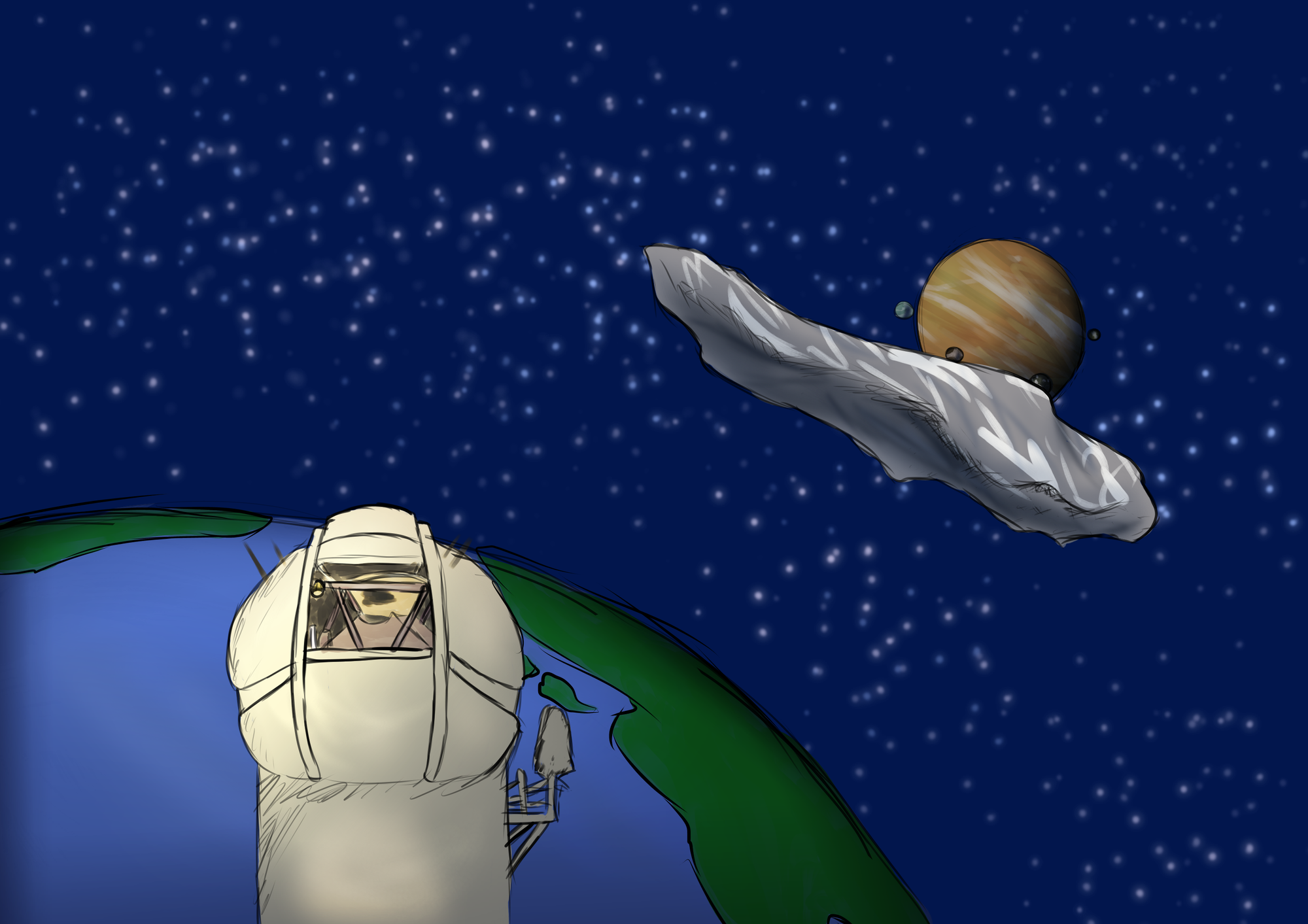An Interstellar Visitor
Science offers the privilege of following evidence, not prejudice.

Science offers the privilege of following evidence, not prejudice.
The Pan-STARRS survey was established to identify near-Earth objects larger than the size of a football field, following a task given to NASA in 2005 by the US Congress. Based on the Haleakala summit in Hawaii, its roving telescopes have identified many such asteroids or comets.
And then, they’ve identified things that aren’t quite either.
On October 19, 2017, Pan-STARRS picked up something strange. One of the objects it had tagged as “near Earth” appeared to be moving fast—too fast to be bound to the Sun. Upon further analysis, scientists realised this object was probably not from the Solar system at all.
They had found the first reported interstellar object—that is, an object from the system of another star.
I was intrigued by this first interstellar visitor because, a decade earlier, I had co-authored a paper forecasting based on what we know about the Solar system, that Pan-STARRS would not detect any rock from other stars.
Naturally, when I heard about this new discovery, I decided to investigate closer.
When we observe the sky closely enough, we always discover something new about the way the world works. This was true during the time of Italian astronomer, Galileo, who turned his telescope towards the moons of Jupiter—and it is equally true today. It is only the context and specifics of the discovery that are different.
Of course, how soon that discovery is accepted is another matter.
During Galileo’s time, it was assumed that the Sun and planets moved around the Earth. After all, given that we see the Sun rise from the horizon, trace a full circle around us, and set in the other direction, such a conclusion seems pretty obvious. The Earth, it was thought, was the centre of the Universe—and everything else moved around it.
Imagine Galileo’s surprise, then, when he turned his telescope towards Jupiter and saw something that does not move around the Earth—namely, the four largest moons of Jupiter. Given all the complicated calculations necessary to explain the movement of the planets, perhaps it could all be explained by the fact that they didn’t move around the Earth either?
Galileo named his newly discovered objects the “Medicean stars”, after his patrons the Medicis. Since there was no concept of “moons” at the time, they remained as stars through much of the seventeenth century.
Even the new Pan-STARRS discovery took some time to be properly classified, but from the beginning, it had a special name: ‘Oumuamua, which is Hawaiian for “a messenger from afar, arriving first”
Unlike Galileo’s moons, ‘Oumuamua didn’t show any strange signs at the beginning. At first, astronomers thought it was a rogue comet—possibly one from another stellar system that had escaped its parent star and blundered towards our own. Interesting, to be sure, but not out of the ordinary.
Comets, though, are distinguishable by their “tail”, the haze of evaporating material that comes out when they get close to the sun. ‘Oumuamua had no such tail to speak of.
And then, if ‘Oumuamua was from another star, the question was: which star?’
Going for a walk outside your house, you are moving relative to the trees and lamp-posts around you. But this motion is nothing compared to the motion of our planet, hurtling on through its journey around the Sun and taking everything with it—you, the trees, the buildings, and even the Moon. Similarly, if you zoom out, the Earth and sister planets take their motion from the Sun. And, even if they escape the Sun’s grasp and begin a journey through interstellar space, they will be moving at a more or less similar speed and direction.
This is a handy way to detect where an interstellar visitor came from: match its velocity with those of various stars.
But instead of matching a star, ‘Oumuamua’s motion was found to match the so-called “Local Standard of Rest”. This is the average speed of all the nearby stars, which is close to saying something is not moving at all. Except for a 1 in 500 chance, the odds were that ‘Oumuamua did not come from any star but was just…floating on its own through interstellar space.
These were just the initial anomalies that made ‘Oumuamua different from all the comets and asteroids that we had seen before in the Solar system.
More anomalies were to follow. From the way it reflected light, it was concluded that, rather than being spherical or cigar-shaped, ‘Oumuamua was more like a disk. The chemical makeup didn’t match that of a comet either, and the lack of heat, detectable in the infrared, placed an upper limit of about 200 metres on its size: on the scale of a football field.
More remarkably, ‘Oumuamua exhibited an excess push away from the Sun which, if it was caused by the rocket effect from normal cometary evaporation, would have required it to lose about10% of its mass. Such evaporation was absolutely ruled out by data from the Spitzer telescope data; moreover, the repulsive force declined smoothly with distance from the Sun, showing no change in spin or sudden kicks as routinely observed from jets on the surface of comets.
Finally, there was no apparent cut-off in the push at the distance beyond which evaporation of water ice by sunlight is expected to stop.
The excess force without a cometary tail convinced me that this object is not a familiar rock.
Many years later, in 2010, a rocket would blast off from the Tanegashima Space Centre in southern Japan. Aboard would be mankind’s first-ever demonstration of “light sail” technology in outer space. This involves making a sort of interstellar kite, so thin and reflective that it is propelled forward by light itself.
Back when ‘Oumuamua was under analysis, I reasoned that it may be a thin object being propelled forward by light too. This would be consistent with the way it was being pushed away from the Sun. For the reflection of sunlight to exert a strong enough force, the object would have to be thinner than a millimetre.
Since nature does not make thin objects, I suggested that it might be artificial in origin. This possibility was intended to encourage scientists to obtain a high-resolution image of ‘Oumuamua-like objects in the future.
It is often said that “a picture is worth a thousand words.” In my case, a picture is worth 66 thousand words, the number of words in my book, ‘Extraterrestrial’. The book describes the many anomalies that make ‘Oumuamua different from any known comet or asteroid we had seen before. And since it was first to be reported, it should have been typical. This discovery was a wake-up call that we are missing something about our cosmic neighbourhood.
I would never have had to write my book if we’d had a megapixel image of ‘Oumuamua.
Some “experts” on space rocks dismissed the anomalies of ‘Oumuamua as a credible reason for considering its artificial origin. But these anomalies will not go away if we ignore them and use authority, groupthink or the number of “likes” on Twitter to argue abstractly for a natural origin.
When Galileo announced his new celestial discovery, not everyone was happy with that either.
I believe ‘Oumuamua will never be a regular rock, just as the Earth continued to move around the Sun even when philosophers refused to look through Galileo Galilei’s telescope. They insisted that everyone knows the Sun moves around the Earth and placed Galileo under house arrest.
Today, they would have cancelled him on social media.
In September 2020, another object was discovered by Pan-STARRS sharing ‘Oumuamua’s anomalies of no cometary outgassing and excess push by the reflection of sunlight. It was given the astronomical name 2020 SO and was later found to be a rocket booster from a 1966 mission to the Moon.
The object had thin walls and hence a large area for its mass. It was not designed to be a light sail, but was thin for a different purpose.
This discovery illustrates that the difference between a rock and an artificial object can be inferred from the unusual dynamics of an object. We know that humanity manufactured 2020 SO. The question is: who manufactured ‘Oumuamua?
Just as for Galileo, ‘Oumuamua’s data were collected by looking through our best telescopes. Practising scientists who attempted to explain the anomalies of ‘Oumuamua by a natural origin were all forced to contemplate objects never seen before.
Perhaps the object had a porous structure with a mean density a hundred times lower than air? But such an object is unlikely to maintain its integrity after being heated to hundreds of degrees by the Sun.
Another theory suggests fragments from tidal disruption. But the shape causes a problem: in such cases, it’s much more likely to be that of a cigar than a disk.
What about being a nitrogen iceberg chipped off the surface of a planet like Pluto around another star? That sounds plausible to start with, but this would imply an abundance of objects like ‘Oumuamua scattered through space. And if those objects were being created through “icebergs chipping off”, well, there simply wouldn’t be enough material to account for all of it.
A cave dweller finding a cellphone would argue that it is a rock of a new type. Were earthlings, studying the anomalies of ‘Oumuamua, behaving the same way?
One colleague of mine, specialising in solar system rocks, said of ‘Oumuamua that “this interstellar object is so weird … I wish it never existed.” This makes sense if people are looking to you for answers, but this sentiment also explains why innovation is often suppressed in the face of anomalies.
Mainstream scientists would prefer these anomalies to go away in order to maintain the prestige that they can forecast all data with their existing knowledge. They find anomalies to pose a threat to their status as “experts” in the field.
Thanks to the generous donations from people who were inspired by the vision of my book Extraterrestrial, I was able to inaugurate the Galileo Project in July 2021.
One of the primary goals of the project is to search for ‘Oumuamua-like objects in future surveys, like with the upcoming Vera Rubin Observatory. An early alert to ‘Oumuamua-like objects would allow us to design space missions that would intercept their trajectories and take close-up photographs of them. Such data could resolve their nature and unambiguously determine whether they are natural or artificial in origin.
Finding equipment from an extraterrestrial technological civilization would have a major impact on the future of humanity. Here’s hoping that we will be open-minded enough to search for objects that resemble the equipment that our technological civilization is launching to space.
We know that half of the Sun-like stars host a planet the size of the Earth roughly at the same separation. Many of these stars formed billions of years before the Sun, allowing for the possibility that numerous probes were sent to interstellar space. Ridiculing the notion that ‘Oumuamua may have been artificial in origin will not get rid of our neighbours. As Galileo Galilei instructed us four centuries ago, the nature of celestial objects must be found through our telescopes rather than philosophical prejudice.
